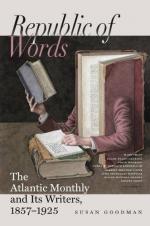* * * * *
THE TEST.
Musa loquitur.
I hung my verses in the wind;
Time and tide their faults may find.
All were winnowed through and through;
Five lines lasted sound and true;
Five were smelted in a pot
Than the South more fierce and hot.
These the Siroc could not melt,
Fire their fiercer flaming felt,
And their meaning was more white
Than July’s meridian light.
Sunshine cannot bleach the snow,
Nor Time unmake what poets know.
Have you eyes to find the five
Which five thousand could survive?
RECOLLECTIONS OF KEATS.
BY AN OLD SCHOOL-FELLOW.
In the village of Enfield, in Middlesex, ten miles on the north road from London, was my father, John Clarke’s school. The house had been built by a West India merchant, in the latter end of the seventeenth or beginning of the eighteenth century. It was of the better character of the domestic architecture of that period,—the whole front being of the purest red brick, wrought, by means of moulds, into rich designs of flowers and pomegranates, with heads of cherubim over two niches in the centre of the building. The elegance of the design and the perfect finish of the structure were such as to secure its protection, when a branch railway was brought from the Ware and Cambridge line to Enfield. The old school-house was converted into the station-house, and the railway company had the good taste to leave intact one of the few remaining specimens of the graceful English domestic architecture of long-gone days. Any of my readers who may happen to have a file of the London “Illustrated News,” may find in No. 360, March 3, 1849, a not prodigiously enchanting wood-cut of the edifice.
Here it was that John Keats all but commenced and did complete his school-education. He was born on the 29th of October, 1795; and I think he was one of the little fellows who had not wholly emerged from the child’s costume upon being placed under my father’s care. It will be readily conceived difficult to recall from the “dark backward and abysm” of nearly sixty years the general acts of perhaps the youngest individual in a corporation of between seventy and eighty youngsters; and very little more of Keats’s child-life can I remember than that he had a brisk, winning face, and was a favorite with all, particularly with my mother.
His maternal grandfather, Jennings, was proprietor of a large livery-stable, called “The Swan and Hoop,” on the pavement in Moorfields, opposite the entrance into Finsbury Circus. He had two sons at my father’s school. The elder was an officer in Duncan’s ship in the fight off Camperdown. After the battle, the Dutch Admiral, De Winter, pointing to young Jennings, told Duncan that he had fired several shots at that young man, and always missed his mark;—no credit to his steadiness of aim; for Jennings, like his own admiral, was considerably above the ordinary dimensions of stature.




